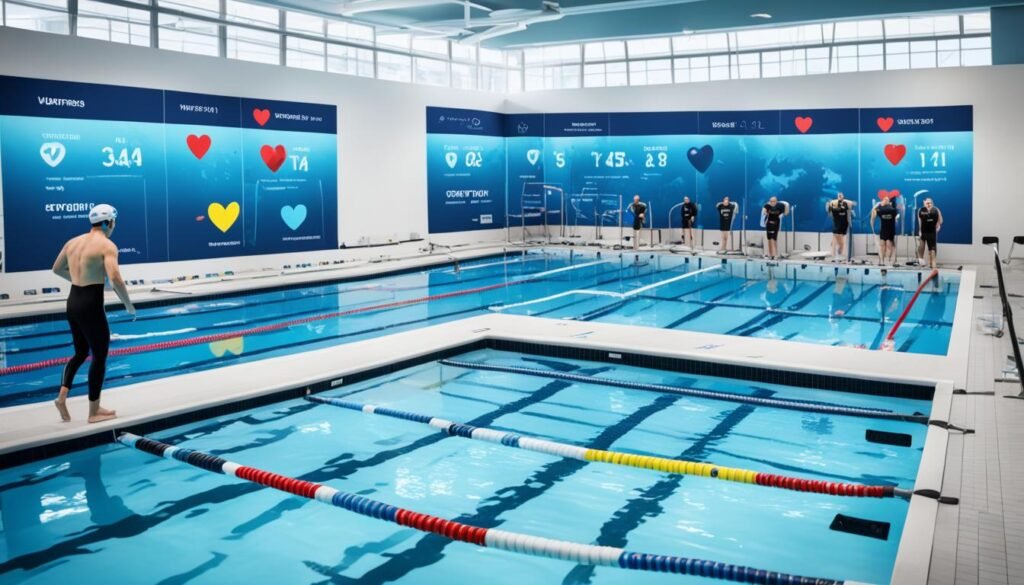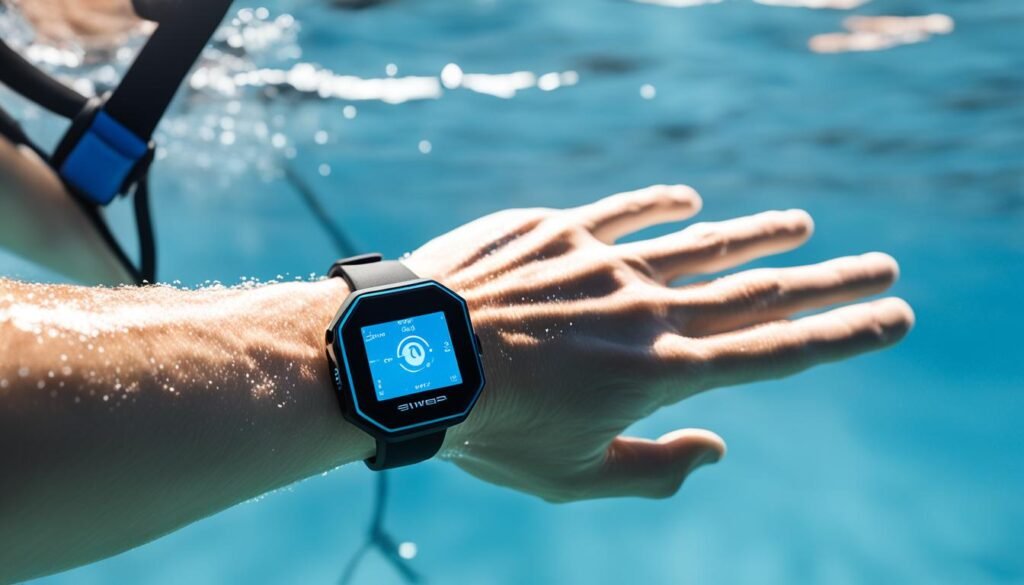Monitoring your heart rate live while swimming is key for swimmers wanting to boost their performance. It lets athletes shape their workouts for the best outcomes and stay safe in the water. With wearable trackers, swimmers get instant access to their heart rate data.
This is a big help in analyzing and enhancing performance. Today’s market has many swim-specific heart rate monitors. They come with features made just for water athletes. This tech makes it easier to monitor and improve your exercise sessions.
Key Takeaways
- Live heart rate monitoring while swimming optimizes training and safety.
- Understanding how to do live heart rate monitoring while swimming can enhance performance.
- Wearable fitness trackers provide essential real-time data.
- Swimming heart rate monitors are specifically designed for aquatic environments.
- Utilizing advanced technology can lead to improved swim outcomes.
Introduction to Live Heart Rate Monitoring
Live heart rate monitoring is vital for swimmers to improve their workouts. It shows how the body reacts to different exercise levels. This helps athletes to train better.
By tracking heart rate in real time, swimmers can make quick changes. This ensures their swim sessions help them meet their fitness goals.
It offers insights into how well the heart works and exercise intensity. This tells swimmers if they’re pushing too hard or not enough. It helps them stay in their ideal effort zone for better results.
The key benefit of this monitoring is making workouts more efficient. Knowing their heart rate lets swimmers adjust their effort. They can avoid doing too much or too little. This leads to quicker improvements.
Using live heart rate monitoring helps athletes fine-tune their training. It allows for a personalized fitness approach. This leads to better performance in the water.
Benefits of Monitoring Heart Rate While Swimming
Understanding how monitoring your heart rate can improve swimming is key. It helps manage your training’s intensity. By watching your heart rate, you know if you’re working out just right. This makes sure your workouts are safe and beneficial.
Another big plus is it allows for workouts that fit you perfectly. Knowing your heart rate lets you adjust your training to meet your specific needs. This leads to more effective sessions and better outcomes over time.
- Prevention of overtraining: Accurate heart rate checks prevent too much strain, lowering injury and burnout risks.
- Enhanced safety: Keeping an eye on heart rates makes sure swimmers stay within safe limits during tough workouts.
- Improved recovery: Checking heart rate after exercise helps understand rest needs. This ensures better recovery and readiness for next time.
Studies prove these benefits. They show heart rate monitoring boosts performance analysis for swimmers. Including it in your swimming routine makes you more in tune with your body. It takes your training further.
Choosing the Right Wearable Fitness Trackers
Selecting the right wearable fitness tracker can make your swimming better. When picking a tracker for swimming, look for certain key features. These features are important to make sure you buy a device that fits your needs.
Top Features to Look For
Consider these important features:
- Water Resistance: Seek trackers that can handle water well, ideally with an IP68 rating.
- Heart Rate Accuracy: It’s vital to get precise heart rate data. Look at user reviews to find the best ones.
- Bluetooth Connectivity: Bluetooth lets you connect your tracker to your phone. This makes it easy to check your workout data.
- Battery Life: A tracker with long battery life helps during long swims. Aim to get one that lasts.
- Comfort: A comfortable fit is key. It shouldn’t bother you while you swim.
Recommended Brands and Models
Looking for the best in swimming trackers? Here are some top picks:
| Brand | Model | Key Features |
|---|---|---|
| Garmin | Swim 2 | Tracks your pool swims, gives smart notifications, and provides advanced swim metrics |
| Polar | OH1 | Offers optical heart rate monitoring, Bluetooth for syncing, and a design that resists water |
| Suunto | Suunto 9 | Has multi-sport functionality, GPS tracking, and great battery life |

How to Do Live Heart Rate Monitoring While Swimming
Monitoring your heart rate while swimming boosts your training. Focus on two key points: setting up your device and calibrating your heart rate monitors. These steps ensure a smooth heart rate tracking setup.
Setting Up Your Device
To start, set up your heart rate monitoring devices as the maker instructs. Brands like Polar and Garmin offer easy-to-follow manuals. They walk you through linking to apps or smartwatches. Make sure the device is set for water use.
Follow this simple checklist:
- Charge the device fully before first use.
- Download and install the needed app.
- Pair your device with the app using the on-screen steps.
- Set it for waterproof mode and notifications.
Calibrating for Accurate Readings
Correct calibration means accurate heart rate readings while swimming. Calibrate your monitor before swimming. Input details like age, weight, and fitness level. Here’s how to calibrate your device:
- Go to calibration settings in your app or device.
- Enter your personal information as asked.
- Choose a reference activity, like running or a swim.
- Test the device indoors to check it’s working right.
After calibration, test the monitor in your first swim. Watch how water temperature affects heart rate data. Tune the settings as needed for more accurate tracking.
Understanding Swimming Heart Rate Monitors
Swimming heart rate monitors mix technology and convenience for those who love water fitness. They track your heart rate in real time as you swim. This helps you train better. These monitors offer benefits not found in regular heart rate monitors.
Swimming monitors use optical and electrical sensors. Optical sensors measure heart rate with light. Electrical sensors detect the heart’s electrical signals. Each type works differently and has its own benefits.
- Optical Sensors: They shine light on your skin and measure the light that bounces back to check your heart rate. They are easy to use and comfortable.
- Electrical Sensors: These need to touch your chest to work. They are great for accurate readings during hard workouts.
Swimming heart rate monitors are built to work well in water. They are strong enough to give you exact data while you swim. Knowing how these monitors work helps you choose the right one for you.
Waterproof Heart Rate Sensors: A Must-Have
Swimming is a great way to exercise. But, it’s better when you monitor your heart rate accurately. Waterproof heart rate sensors are made for this. They are key in picking the right device. Look at materials, designs, and their IP68 rating for water resistance.
What Makes a Sensor Waterproof?
Waterproof sensors are built tough. They use strong materials like silicone. This keeps water out. Seals and gaskets protect the inside parts. An IP68 rating means they’re dust-tight and can go underwater for a long time. This makes them perfect for swimming.
Popular Waterproof Sensor Options
Looking for the best heart rate sensors for swimming? Here are top picks:
| Device | Waterproof Rating | Key Features | User Feedback |
|---|---|---|---|
| Wahoo TICKR X | IPX7 | Dual Bluetooth and ANT+ connectivity, built-in memory | Highly rated for accuracy and comfort |
| Garmin HRM-Swim | 5 ATM (IPX7) | Swim tracking capabilities, durable design | Praised for functionality in open water |
The Wahoo TICKR X and Garmin HRM-Swim stand out. Fitness forums praise them for performing well in water. Choosing between them can make swimming more fun. This means you get heart rate data in real time, with no fear of breaking your gear.

Real-Time Heart Rate Data: Using Your Findings
For swimmers, real-time heart rate data helps make training better. Athletes can see how hard they’re working by checking their heart rate. This lets them change their speed and how they swim during practice.
It’s important to know about heart rate zones. Swimmers can then train smarter, aiming for specific goals. For instance, some zones build endurance, and others boost speed.
The FORM Smart Swim 2 goggles are 97% accurate in showing heart rate. They’re better than ECG chest straps because they let swimmers see their heart rate right away. Swimmers can then adjust their effort instantly.
Real-time heart rate data also helps during rest times. Knowing when the heart rate goes back to normal can guide how much to train and rest. This makes swimmers perform better overall.
Want to learn more about heart rate tech for swimmers? Check out this resource. It could help swimmers train better and reach new heights.
| Heart Rate Zone | Target Heart Rate (% of Max HR) | Benefits |
|---|---|---|
| Resting | Below 60% | Recovery and rest |
| Aerobic | 60%-70% | Improved endurance |
| Threshold | 70%-80% | Increased stamina |
| Maximal | 80%-90% | Boosts speed and power |
Using real-time heart rate data changes how swimmers train. It leads to better performance and more focused training plans.
Analyzing Heart Rate for Swim Workouts
For swimmers looking to boost their performance, understanding their target heart rate zones is key. This lets them adjust their efforts to make the most of each swim. We’ll explore how swimmers can find the right intensity for different training needs in this section.
Creating Target Heart Rate Zones
To set up heart rate zones, first figure out your max heart rate. Start with the basic formula: 220 minus your age. Then, break this max number into zones:
- Zone 1 (50-60% of max HR): Perfect for warming up or cooling down.
- Zone 2 (60-70% of max HR): Good for endurance work.
- Zone 3 (70-80% of max HR): Targets speed improvement.
- Zone 4 (80-90% of max HR): Highest effort for top outcomes.
Keeping an eye on these zones during workouts helps swimmers understand their efforts better. It shows them how to enhance performance and stamina over time.
Interpreting Heart Rate Analytics for Swimmers
Reviewing heart rate data after swimming is crucial. Tools from swim trackers offer insights into heart rate patterns across different parts of a session. Focus on these details:
| Metric | Importance |
|---|---|
| Average Heart Rate | Shows the overall effort level. |
| Max Heart Rate | Indicates the peak effort. |
| Recovery Heart Rate | Tells how fast you recover, showing fitness level. |
| Time Spent in Each Zone | Helps evaluate how well workouts meet goals. |
Using this data not only improves workout quality but also helps swimmers plan better recovery and take care of their heart health. It enables a more personalized training plan for smarter decisions.
Conclusion
Using live heart rate monitoring during swim workouts is a big step forward. It helps understand and better our performance in water. Tracking your heart rate as you swim is crucial. It lets you exactly adjust how hard you train. This is great for both fun swimmers and serious competitors. With the correct gear and know-how, your swimming practice can get much better.
Heart rate tech for swimming gives you instant feedback on your effort. It also lets you see how you improve over time. This way, you can make workout plans that are just right for you. It helps you meet your swim goals. So, using heart rate monitors for swimming definitely boosts how well you do in the pool.
Last thoughts on swimming heart rate tech show it changes how we practice swimming. It encourages workouts based on solid data that meet individual needs. It’s time to try heart rate monitoring in your swim routines. See for yourself how it can up your game.
